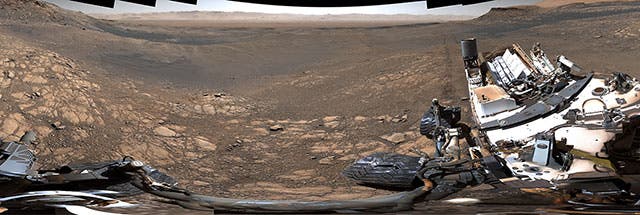For eight long years, NASA’s Curiosity rover has been beaming back incredible images — not to mention scientific findings such as evidence of ancient streambeds and key ingredients for life. Today, we’re in for a special treat.

It’s the mother of all data dumps: Curiosity uploaded 1,200 images captured from its vantage point atop the rim of Gale Crater. Taken over the span of four days, the images were stitched together to form one single massive high-resolution panorama.
The image featured in this article is just a sample. In order to enjoy all 1.8 billion pixels in the composite image, you can head over to NASA’s website where you can download a 2.25 GB file. For a rundown of all the most important landmarks present in the image, check out this well put together video embedded below.
The images used in the panorama were taken for six and a half hours over the course of four days between Nov. 24 and Dec. 1, when the mission team was out for the Thanksgiving holiday. However, before they left for the holidays, engineers programmed the complex task list, which included pointing the rover’s mast and making sure the images were in focus.
“While many on our team were at home enjoying turkey, Curiosity produced this feast for the eyes,” said Ashwin Vasavada, Curiosity’s project scientist at NASA’s Jet Propulsion Laboratory, which leads the Curiosity rover mission. “This is the first time during the mission we’ve dedicated our operations to a stereo 360-degree panorama.”

Credit: NASA/JPL-Caltech/MSSS.
If you thought these images were cool, wait until you see what NASA’s upcoming Mars 2020 rover will come up with. It’s scheduled for launch this July and scheduled to land on the red planet in February 2021. Today, NASA announced that Alexander Mather, a seventh-grade student in Virginia, is the winner of a nationwide contest to name the rover. As of today, NASA 2020 is known as Perseverance.
“Alex’s entry captured the spirit of exploration,” said Thomas Zurbuchen, NASA’s Science Mission Directorate’s associate administrator. “Like every exploration mission before, our rover is going to face challenges, and it’s going to make amazing discoveries. It’s already surmounted many obstacles to get us to the point where we are today — processing for launch.”Alex and his classmates are the Artemis Generation, and they’re going to be taking the next steps into space that lead to Mars. That inspiring work will always require perseverance. We can’t wait to see that nameplate on Mars.”


